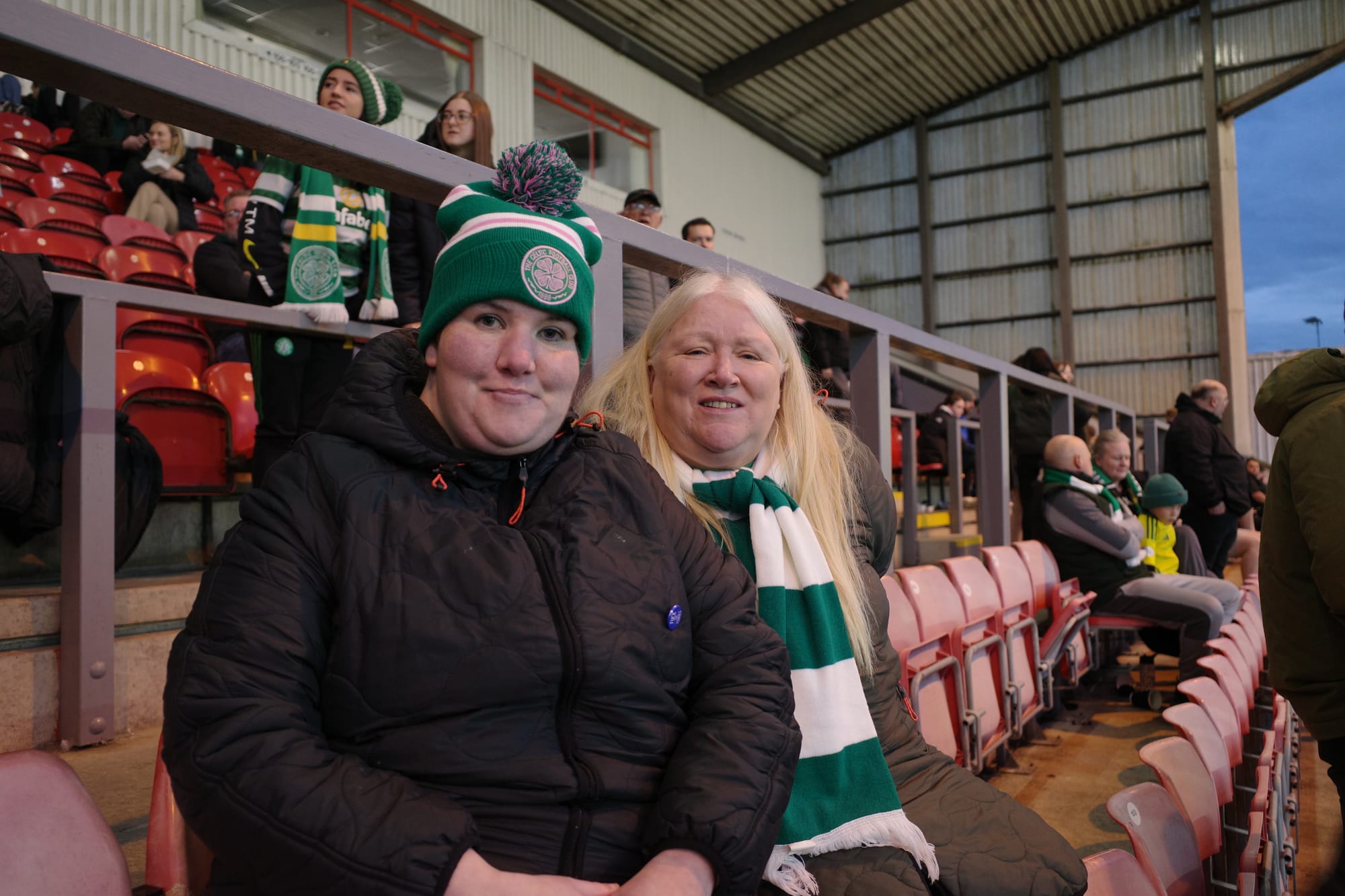It’s Thursday evening – the sky like October leaves – and I’ve finally found a taxi driver willing to take me to Cumbernauld. This proved more difficult than expected, and I arrive at Broadwood Stadium a couple of minutes late for my assignment. From the car park where my driver drops me off, I can vaguely hear the sound of German techno outfit Scooter blasting from stadium speakers, heralding a goal. Just four minutes into the first Old Firm derby of the Scottish Women’s Premier League, and Rangers have already scored against Celtic.
Across the UK, women’s football is finally claiming its place in the limelight. Registered female football teams in England have doubled over the last seven years, with 1,500 new teams popping up in just 12 months following the national side’s 2022 win at the Euros.
A 2023 Time magazine article about the rise of women’s ‘soccer’ in ‘Britain’ (translation: ‘football’ in ‘’England’) also partially credits the Lionesses’ Euros victory for the popularity boost, but adds that increased funding, favourable coverage in the press, and the 2015 Women’s World Cup – the first to be televised in its entirety by the BBC – have also had a profoundly positive impact on the sport.
There’s been more attention for women’s football on our side of the border too. Last year saw domestic viewers of Scottish women’s football nearly double, and Sky Sports reported a record-breaking increase for at-home audiences during the last season of the Scottish Women’s Premier League. The match that pushed viewing figures above previous records was (of course) between Celtic and Rangers, and boasted a peak domestic audience of over 145,000.
Today's derby, then, is appropriately busy — albeit with activity condensed into a single half of the stadium, the other stands lying empty. I enter Broadwood to the sound of arrhythmic drumming and chants of “cheat!” coming from blue and green supporters alike. Unlike men’s Old Firm matches, everyone enters via the same turnstiles and sits on the same side of the stadium, divided only by a metaphysical barrier of allegiance.
There’s cheering, singing and various loud, outraged accusations of connivery directed at the referee. This wall of noise is a familiar one from other Old Firm matches, but with voices pitched that bit higher. I head to the Celtic side and my colleague, Moya, takes a seat among the Rangers fans. After much pre-match debate on who should go where, we decided that the Unionists would be more sympathetic towards her English accent.

The history of women’s football, in Scotland and Glasgow, is a rich and overlooked one. The first known women’s football match to be played under Football Association (FA) rules took place at Hibernian Park (now Easter Road) in Edinburgh on 7 May 1881, and saw the Scottish women’s team annihilate their English rivals in a three-nil victory (some records have called the players' actual nationalities into question but a win is a win).
A rematch was soon organised in Glasgow, but was abandoned mid-game due to pitch invasions. When the British Ladies Football Club was formed in London four years later, in 1885, it was a Scottish woman, Lady Florence Dixie, who was installed as president. Mary Queen of Scots is even suspected of being the owner of the world’s oldest football – which was crafted in Stirling (and still resides there).
But it would be in bad faith to pretend that the Scots have always looked favourably upon the female footballer. When England’s FA banned women’s football from member clubs in 1921, the Scottish FA followed suit. They weren’t so quick to lift it; Scotland lagged behind England by four years in reversing the ban.
By then, two years had passed since the country’s women footballers had rebelled and formed their own football association, even playing an international match against an English side. Amid these struggles, a young woman was busy making her name as one of Scotland’s most talented footballers: Rose Reilly, whose sporting legacy recently warranted one of the greatest honours known to (wo)man – seeing a Govanhill boozer named in her honour.
As a child in the 1960s, Reilly was only permitted to play for her local team on the condition that she cut her hair and go by the name ‘Ross’. In this guise, she was scouted by Celtic, but was soon dropped when they found out she was a girl. Later, Reilly was banned from playing for Scotland by the SFA, which backfired when she went onto win championship titles for Italian and French teams instead.
In the present, last August saw the 50th anniversary of women’s football being legal and SFA approved (sort of) in Scotland. Many of the young girls cheering alongside me in Broadwood’s stands have never known a time when it wasn’t. The same cannot be said for Margaret, who is wrapped against the autumnal chill in a black puffer jacket and a green-hooped scarf and gloves set. Margaret is 60, from Pollokshaws, and has come to the match with her 34-year-old daughter Holly. The pair attend every game played by Celtic Women. “This is our third year coming to watch the girls,” she grins. “And I have to say it’s really quite good.”
Margaret and Holly, like many people I speak to at the match, used to be regular attendees at the men’s games. But the rising cost of tickets (a Celtic F.C season pass for the men’s team will set you back £579) have priced them, and many other fans, out. In comparison, a Celtic Women’s season ticket is £130. An adult single for today’s match was just £7.
Have Margaret and Holly seen a change in crowd size during their three years of attendance? “Hugely. When we first started coming you’d be lucky to have half the crowd we have here,” says Margaret, gesturing to the stands. “But look at it now.” She admits the derby draws the most spectators; it’s often a different story when Celtic are up against smaller, more local teams. “But when we’re playing Rangers, or maybe even Aberdeen, Hibs or Hearts, that’s when you see the bigger crowds.”
The large numbers of new fans pulled in by Old Firm matches have caused some speculation over whether there’s increased conflict between the teams. A BBC article published in January questioned if the established animosity between the Celtic and Rangers’ men’s sides is “seeping into [the] women’s game”. The story quotes Rangers Women striker Jane Ross, who claims that “the Old Firm rivalry is really starting to get into it… definitely a noticeable difference compared to a couple of seasons ago.”
On the flipside, Glasgow Greens councillor Holly Bruce was recently quoted in the Glasgow Times, urging men’s Old Firm fans to celebrate “like Celtic women’s fans” i.e. “without disruption.”

Sitting with the Celtic Women fans now, the atmosphere is far from disruptive, although Celtic are currently losing two-nil, and who knows how the rest of the night will go. I ask Margaret if she feels that the Old Firm rivalry is really starting to heat up. “Personally I think yes, because I’m quite vocal about it!” she says. I ask her in what way. “We’ve all got our wee songs,” she explains, “but they’re a bit sweary so I won’t say.”
But other than harmless songs and the odd insult hurled at the referee (who does a stellar job of making enemies on both sides) there’s no noticeable agg between the two teams. Margaret agrees that there’s a striking lack of the sort of behaviour that prompts so much trepidation around Old Firm men’s fixtures. She welcomes it. “There’s no violence, no fights,” she says, “because a lot of young kids come. We try and keep that away for them.”
There are children everywhere in the stands tonight. Front row seats are lined with young girls banging drums and waving flags. A skinny boy in a Celtic scarf, who looks to be around 10, is perpetually leading chants in honour of the girls in green. The calmer fanbase certainly allows for a safer environment, and not only for children. I end up chatting to Margaret’s daughter Holly about the benefits of a quieter match. Holly is 34, and tells me that she loves the women’s games as they’re far more accessible. “Sometimes I find things overwhelming because I’ve got a learning disability,” she says. “And I have a physical impairment as well, so sometimes I need my stick.”
At the women's games, Holly says she consistently receives support from other fans and members of staff. “There’s always someone available to give me a hand,” she says. “And it’s not as overwhelming, it’s not as anxiety-ridden. So I’m trying my best, you know, I’m still here. And I’m still interacting with people.” Does she ever attend the men’s games? “No, just women’s games,” she says. “The men's games are not accessible enough. And they’re quite loud, they’re not good for my anxiety.”
If you're reading this and you haven't yet joined our free mailing list, click here to get Glasgow's new quality newspaper in your inbox every week.
Over on the Rangers side, my colleague Moya is chatting to Ava, 12, from Kirkintilloch. Ava slipped into the seat beside her at half time, and has been providing insightful commentary ever since — at one point muttering that the Celtic team were “better at rugby than football” because they were pushing Rangers around so much.
Ava has been a football fan for as long as she can remember, and started playing for her school’s team at a young age. Women’s football, however, only came into her life in the past few years, “and now I enjoy it more than the men’s,” she says. “It’s a much better environment for somebody my age, and these girls playing on the pitch are more inspiring.”
Ava now attends Rangers Women matches every weekend, without fail. Tonight is an exception; she’s been allowed to see them play on a school night for the special occasion. What are her thoughts on the Old Firm rivalry? “It’s ok! The girls are really cooperative with each other,” she says, referring to the players. And how about the Celtic fans? “They’re just young girls my age,” she answers. “It’s not as if they’re different from me.”
I’m surprised by the number of men in the crowd at tonight's game – accounting for at least a quarter, maybe even a third of the onlooking fans. However, they prove harder to talk to. On the Celtic side, two men promise me an interview later and then promptly disappear. The one man I manage to collar for a chat tells me he’s only here for his daughter, and prefers the men’s games because they’re livelier. His daughter, on the other hand, informs me that she prefers the women’s games because the players take pictures with you after the match.
Luckily, Moya is getting on better speaking to blokes on the Rangers side of the stands. Outside the loos she falls into conversation with Alan, 70, from Stirling, while his granddaughter hovers embarrassedly to one side.
Alan’s been a Rangers supporter all his life, he says; he used to be a driver for the men’s team “many years ago”. Nowadays he rarely goes to men’s matches, but has a season ticket for the women’s. How come?
Well, it’s easier and cheaper to get tickets for the women’s matches, Alan explains, and it means that he can bring his two granddaughters along. Has Alan seen a rise in the popularity of the women’s matches then?
“Yes, in the last month or so,” he estimates. “Since [Rangers] started playing really well.” What about tensions between Celtic and Rangers? “Oh yes, there’s a big rivalry. During the 90 minutes. But you’ve not got them going out and fighting, nothing like that. There’s still a bit of hatred between the two, but it’s not like the men’s game, you don’t need to split the fans.”
Another male Rangers supporter – Derek, 47, from Edinburgh – agrees that the rivalry is mostly kept to the match itself. “I see it more in the game, in the physicalness,” he says. And in the crowds? “It’s a wee bit more friendly, but you can see it’s still there,” he answers. “The older generation are bringing the rivalry though. Naebody likes to get beat.”
By the time the referee – who I’ve heard enough accusations about to justify a separate investigative article – draws the match to a close, Celtic have brought the score back up to a draw, scoring once on a penalty, and then again in the eleventh hour of the game. This is probably for the best – though it means that I don’t get to see what either crowd behave like when they win or lose, or if Celtic Women’s fans are truly the role models in victory Holly Bruce claims them to be.
Yet the overall message from Broadwood’s stands seems to be: women’s matches are cheaper, quieter, calmer and generally more accessible to a wider group of people. The broiling tension and baggage that comes attached to the men’s Old Firm teams, does not seem to have migrated to the women’s game – yet.
Kim, a 65-year-old Rangers supporter, who demonstrates a pundit level knowledge of the game, probably sums up fan sentiments the best. “Football is out of reach for a lot of folk,” she says, “or you’re having to invest an awful lot of money. Whereas tonight you can just say ‘Oh, let’s take the kids, let’s go, jump in the car.’ I hope that remains.”
And as for the Old Firm rivalry? “There’s always a rivalry,” she answers, “but it’s of a different nature. It’s hard to put into words, you can only know when you feel it. It doesn’t have that male testosterone and all that goes with that, though, and I think that’s a good thing.”
Additional reporting by Moya Lothian-McLean.
Comments
How to comment:
If you are already a member,
click here to sign in
and leave a comment.
If you aren't a member,
sign up here
to be able to leave a comment.
To add your photo, click here to create a profile on Gravatar.







